On March 8, an international scientific review board will be evaluating the research at the French CNRS Institut de Biologie Moléculaire des Plantes (IBMP) in Strasbourg. This is the place where the former star (and now misconduct-tainted pariah) of plant sciences Olivier Voinnet shot to fame, where his main lab operated since 2002 until he was taken away control over it in 2015, after found guilty of massive data manipulations in many papers by his employers CNRS and ETH Zürich (see my various reports here). The Voinnet lab in Strasbourg had since been led by his right-hand man, Patrice Dunoyer, first author on 3 retracted papers, who also admitted his own data manipulations in several more instances (most recent Voinnet/Dunoyer retraction and correction list here). A serious institute might have reconsidered collaborating with such a questionable scientist as Dunoyer, not so CNRS and its IBMP (which is actually just as fair, because also the Swiss ETH kept his boss Voinnet as their professor). Dunoyer was only punished by a one-month suspension back then in 2015, to CNRS leadership he seems to be a perfect scientist to lead a research lab in this plant science institute. Indeed, Dunoyer is apparently well integrated at IBMP: on March 8th the review board will not only be judging his scientific performance, but also that of his several IBMP colleagues whose publications were also flagged for data integrity concerns on PubPeer, e.g. Christophe Ritzenthaler, Véronique Ziegler-Graff and Pascal Genschik. Incidentally, IBMP invited as review committee members such international scientists who will be well able to understand this delicate matter, because, like for example Martin Crespi, director of the Institute of Plant Sciences in Paris-Saclay, or Serge Delrot, professor at University of Bordeaux, their own publications were reported on PubPeer for serious data integrity concerns as well. One could quip here: it takes one to know one.
Here is the talk presentation programme and the composition of the so-called “Comité HCERES” scientific review board (Update 14.02.2017: the original links were deleted right after my article was published, I replaced programme with my own back-up):
Scientific delegate, in charge of setting up the board : Serge Delrot
Members: Gordon Simpson (Chair), Joszef Burgyan, Cristel Carles, Martin Crespi, Philippe Gallusci,
Marjorie Juchaux, Claudine Mayer, Mario Pezzotti, Alain Tissier, Ute Vothknecht.

The Examiners
I contacted all committee members who had their papers flagged on PubPeer, only two have replied so far (quoted below). There are three publications featuring the HCERES scientific delegate Delrot with concerns on PubPeer, Mahjoub et al 2009 (from his own lab), as well as collaborative works Laquitaine et al 2006 and Gomes et al 2003, where gel duplications and inappropriate gel splicing were criticised.
Joszef Burgyan, group leader at the Hungarian Agricultural Biotechnology Center, replied to me in regard to this collaborative paper Várallyay et al 2010 with an apparent band duplication:
“Thank you for your mail and information in it. Regarding the EMBO paper in which I am co-author I forwarded your mail to Dr. Havelda who is the corresponding author of this paper and all experiments were done in his lab. He will answer how happened that these figures are really similar. My role in this work was providing different materials for the experiments and discussing the manuscript, of course I did not realize the suspicious similarity of the two control lanes in Fig. 8.
Thus, I don’t want to comment it before the explanation of Dr. Havelda, but if they are the same he should inform the journal and correct it.
As for my participation of IBMP evaluation panel. I am sure that these are important issues and should be discussed by the panel, however I think this is the duty of the panel chair.
Thank you again for your mail and the informations, even if I am not very happy with this “discoveries”.
Crespi replied to me as well, addressing the concerns about these PubPeer-flagged papers made with his participation, Elvira-Matelot et al 2016, Conti et al 2016, Baudin et al 2016 and Campalans et al 2004:
“Thank you for your message. Regarding the Plant Cell paper on SMD1 [Elvira-Matelot et al 2016, LS], a correction has been published and I am also waiting an answer concerning the second paper (Campalans et al.) that was published in 2004 where I am corresponding author. Both cases were stupid and regrettable mistakes made by the first authors without malicious intentions and do not change any conclusion of the papers. Concerning the other two comments, I am co-author of these papers and I was not involved on the figures mentioned in pubpeer. Nevertheless, I am in contact with both corresponding authors to understand what occurred. Based on these exchanges, we will contact the Journals.
Concerning my participation in the IBMP evaluation panel, I cannot comment as the evaluation is ongoing”.

Following is the correction mentioned by Crespi and published for Elvira-Matelot et al 2016 in The Plant Cell on January 25th. To everyone who bothers to look, a single gel band was digitally excised and duplicated into a different background using Photoshop or similar software, yet the authors successfully claimed it was an accidental lane splicing. It seems this elite plant science journal, where Voinnet scandal originally exploded because not only Voinnet’s and Dunoyer’s data manipulations from 2004 but also some unsavoury editorial misconduct were exposed by the whistleblower Vicki Vance (here and here), learned very little from the past blunders:
“A mistake was introduced when assembling the image of the top panel of Figure 4. The original image contained 10 lanes organized as shown in Figure 4 source data (see below); the three Col replicates for ATPase1 (top panel) were not loaded in three adjacent lanes due to a problem in the gel. To show triplicates adjacent to one another as in the bottom panel of Figure 4, lane 7 should have been cut and pasted in place of lane 3. Instead, lane 7 was deleted and lane 2 was duplicated and copied in place of lane 3. The corrected Figure with all original data for each sample is shown here. The correction of this mistake does not alter the conclusions of this paper. In addition, the legend of Figure 4 was amended to define the error bars and the values of the y axes of RNA quantification graphs.
In addition, panel H of Figure 6 was mounted by assembling separate images from two different gels, and this was not indicated. Two boxes are now shown for clarification. This correction does not alter the conclusions of this paper. The legend of Figure 6 remains unchanged.
Co-first author Florian Bardou takes the entire responsibility for making these mistakes and for not informing the other authors of the paper about the manipulated images. Cocorresponding authors Martin Crespi and Hervé Vaucheret take responsibility for not reviewing the data completely before submitting the paper for publication”.
The other paper which Crespi described as “regrettable mistake” is Campalans et al 2004. Can such band duplication really happen to anyone, “without malicious intentions”? Crespi thinks it can, so he will likely be able to understand Dunoyer’s and his IBMP colleagues’ predicament.

Mario Pezzotti, professor at the University of Verona, Italy, could not be reached since my email to him bounced. So I couldn’t ask him about this collaborative paper Bortesi et al 2012, where a gel loading control was duplicated. Other members of review committee preferred not to reply. Philippe Gallusci, professor at University of Bordeaux, was invited on PubPeer to investigate one suspected gel duplication in a paper from his lab (Mortain-Bertrand et al 2008). Marjorie Juchaux, research facility head at University of Angers, is first author on a paper with a likely lane duplication (Juchaux-Cachau et al, 2007). The suspicions for the paper Rontein et al 2007 are even heavier: sections of gel lanes from the lab of Alain Tissier, now professor at Leibniz Institute of Plant Biochemistry in Halle, Germany, seem to have been copy-pasted into different lanes. The issues raised for the paper Chigri et al 2006 from the lab of Ute Vothknecht, now professor at the University of Bonn, Germany, seem even stranger. Make your own call here:
The Examined
These esteemed scientists will now be evaluating the research performance of Dunoyer, the self-admitted master of data manipulation (talk: Regulatory processes of RNA silencing in plants), and some of his group leader colleagues with a record of PubPeer evidence against their publications. What will such a committee think about this obviously duplicated band in Lange et al 2011 from the IBMP lab of Dominique Gagliardi (HCERES visit talk: RNA degradation), a problem which the first author Heike Lange (another questionable achievement of hers is Lange et al 2000) seems not to deny?
Also Christophe Ritzenthaler, Voinnet’s former collaborator (e.g., Himber et al 2003), will be speaking for his evaluation (Biology and biotechnology of grapevine viruses). Yet these three of his problematic papers have nothing to do with Voinnet or Dunoyer: Schellenberger et al 2010, Schellenberger et al 2011, Gaire et al 1999. With such a committee well trained in dealing with band duplications, what kind of judgment is Ritzenthaler to expect? Applause?

There will be also talks by Pascal Genschik (Role of ubiquitin in cellular regulation), as well as Véronique Ziegler-Graff and David Gilmer (Ins and outs of viral infection in plants), who authored papers like Derrien et al 2012 (suspected of band duplication and inappropriate gel splicing), Delfosse et al 2013 (suspected of band and lane duplication), Lechner et al 2002 (suspected duplicated loading control), Verkest et al 2005 (suspected band duplications), Chiba et al 2013 (containing dubious gel splicing).

Update 1.03.2017: A paper from Ziegler-Graff lab featuring Dunoyer as co-author, Pfeffer et al 2002, has been retracted today for data manipulation (PubPeer evidence here, see also comment below).
In this paper from Genschik lab, someone apparently didn’t bother about correct presentation of negative controls at all and used same image six times (Capron et al 2003):
The true enemy of French science?
In case you wonder why I did not ask IBMP or CNRS for their opinion on so many irregularities in the papers by their lead scientists, well, here is why. There was some weeks ago this email from this IBMP researcher:
“Subject: [ibmp-all] demande de la direction
Merci de ne pas répondre au mail de M. Leonid Schneider.
Please do not respond to Mr. Leonid Schneider mail.
Thanks
Géraldine Bonnard
Correspondante de communication
Institut de biologie moléculaire des plantes
CNRS-Université de Strasbourg”
Is this an official CNRS decree? What kind of punishment are their researchers to expect for replying to me? Worse than that one month suspension which Dunoyer got for his excessive data manipulations? When I asked about this email to Bonnard, IBMP director Laurence Drouard as well as the central CNRS Press office (presse@cnrs.fr), I received no reply at all. In fact, Drouard also refused to reply to me about the following information I received from elsewhere: Voinnet himself (who was barred from CNRS for 2 years in 2015) was invited to their IBMP on July 28th 2016, where he spent the day giving his valuable advice to selected group leaders in an European Research Council (ERC) grant application coaching session. You think this is too bizarre? Well, ERC actually has no problem at all with cheating when done by elite scientists they fund (see my report here), so I personally do see the point. Maybe IBMP should be best renamed into The Olivier Voinnet Institute for Research Integrity in Plant Sciences.

Donate!
If you are interested to support my work, you can leave here a small tip of $5. Or several of small tips, just increase the amount as you like (2x=€10; 5x=€25). Your generous patronage of my journalism will be most appreciated!
€5.00







Hi Leonid
Let’s have a little fun here…… how long ’till the next invoice “€250.000 and 6 months” ? 3… 2… 1… gone.
Sorry
Oliver
LikeLike
Before that happens Leonid will be getting more and more people signing the open letter and support to pay his court expenses, for sure
LikeLike
Pingback: Boletim de Notícias, quarta-feira, 15/fev: sinalização para edição gênica de embriões | Direto da Ciência
Everyone seems to be affected, both the researchers at IBMP, as well as the IBMP panel. At least they will understand each other.
LikeLike
And it is remained to be known how this fact will influence the evaluation
LikeLike
Soon after I published this article, some HCERES evaluation committee members who never replied to my emails before, took notice. The first authors of Vothknecht and Tissier suddenly responded to the PubPeer criticisms I flagged in the story above.
“Calcium regulation of chloroplast protein translocation is mediated by calmodulin binding to Tic32”
F. Chigri, F. Hormann, A. Stamp, D. K. Stammers, B. Bolter, J. Soll, U. C. Vothknecht, Proceedings of the National Academy of Sciences (2006)
https://pubpeer.com/publications/B040F8697868168F381C28099B527B#fb117463
“CYP725A4 from yew catalyzes complex structural rearrangement of taxa-4(5),11(12)-diene into the cyclic ether 5(12)-oxa-3(11)-cyclotaxane”
Denis Rontein, Sandrine Onillon, Gaëtan Herbette, Agnes Lesot, Danièle Werck-Reichhart, Christophe Sallaud, Alain Tissier, J. Biol. Chem., 283 (2008)
https://pubpeer.com/publications/B040F8697868168F381C28099B527B#fb117463
LikeLiked by 1 person
Comment on PubPeer regarding the Rontein et al 2008 paper from Tissier lab:
LikeLiked by 1 person
Pingback: Susana Rivas: a new research integrity scandal in French plant sciences – For Better Science
The HCERES committee visiting IBMP on March 8th will be surprised to hear of this:
Retraction for Pfeffer et al., P0 of Beet Western Yellows Virus Is a Suppressor of Posttranscriptional Gene Silencing
S. Pfeffer, P. Dunoyer, F. Heim, K. E. Richards, G. Jonard and V. Ziegler-Graff
Institut de Biologie Moléculaire des Plantes du CNRS et de l’Université Louis Pasteur, 67084 Strasbourg, France
J. Virol. March 2017 vol. 91 no. 6 e00022-17, Volume 76, no. 13, p. 6815–6824, 2002.
http://jvi.asm.org/content/91/6/e00022-17.full
LikeLike
Anna Campalans and Martin Crespi admit data manipulation on PubPeer for Campalans et al 2004, bus dismiss it as scientifically irrelevant:
LikeLike
Pingback: The stinking fish of Strasbourg – For Better Science
Pingback: CNRS lab of Voinnet’s right hand Patrice Dunoyer dissolved by director’s decree – For Better Science
A correction has been published for the 2010 Várallyay paper featured in this post, see https://pubpeer.com/publications/20823831
Luckily neither the highlighted error nor the two additional corrected mistakes did affect the original conclusions of the presented data.
LikeLike
Reblogged this on Chaos Theory and Pharmacology and commented:
Chaotic.
LikeLike
Pingback: Data integrity conspiracy against German research senator Roland Lill? – For Better Science
Pingback: Voinnet’s sidekick Dunoyer welcomed at Nature Plants, despite retractions and admitted misconduct – For Better Science
Pingback: Voinnet’s CNRS investigator Catherine Jessus with own data integrity issues – For Better Science
Pingback: John Innes Centre director Dale Sanders rebuffs a non-peer reviewed internet troll – For Better Science
Pingback: CNRS hits back at the stream of misconduct evidence – For Better Science
Pingback: DFG Senator Roland Lill explains how to do science properly – For Better Science
Pingback: Call to research integrity, or at least a minor revolution at CNRS – For Better Science
Pingback: Anne Peyroche removed as interim CNRS President as her publications are “questioned” – For Better Science